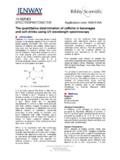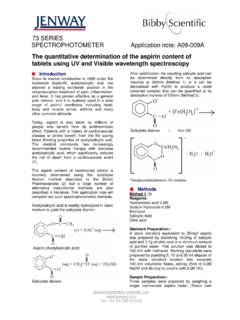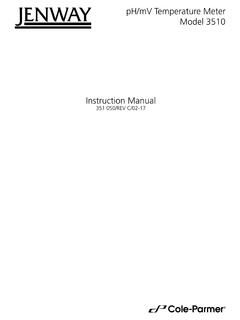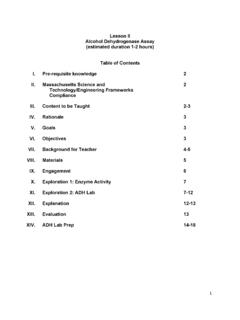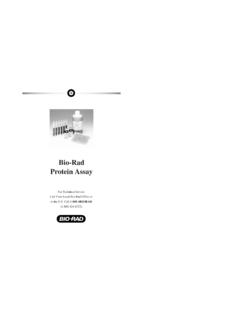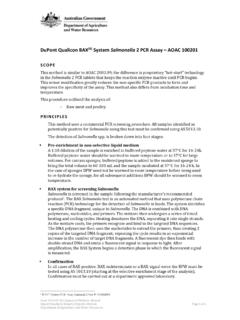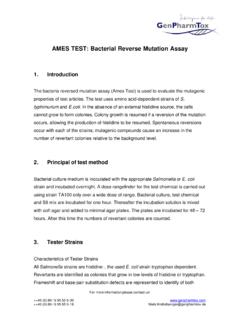Transcription of Genova Protocol: P09-005A - spectrometer| Jenway
1 Tel: +44 (0)1785 810433 Genova protocol : P09-005A Bio-Rad DC Protein assay Introduction The Bio-Rad DC Protein assay is based on the well documented Lowry1 assay . There are two steps to the reaction which results in the formation of solutions with a characteristic blue colour: 1. the reaction between protein and copper in an alkaline medium and 2. reduction of the Folin reagent by the copper-treated protein. The Bio-Rad assay has several improvements over the original assay in that colour development is much faster (within 15 minutes) and the colour is more stable (less that 5% in 1 hour). This assay can be used to quantify proteins in the concentration range from to about It is compatible with many detergents but not compatible with reducing agents such as dithiothreitol above 1mM.
2 It is always advisable to prepare the standard in the same buffer as the sample to minimise any interference effects. Materials required Bio-Rad DC Protein assay Kit (Bio-Rad 500-0111 or 500-0112) Suitable tubes with caps to hold and mix samples Plastic disposable cuvettes ( Jenway 060 084) Method Preparation of the working reagent For each sample, 500 l of reagent A or A are required. 1. If the samples to be tested contain detergent, add 20 l of reagent S to each ml of reagent A needed for the assay . This is now reagent A . 2. Reconstitute the protein standard provided as directed on the bottle. Preparation of samples and standards 1. Turn on the Genova and allow it to warm up. See below for set up instructions. 2. Prepare a series of protein standards ranging in concentration from to such that the final volume for the assay is Examples of dilutions are given in Table 1 below.
3 Note that the Genova can accept up to 6 standards, not including the blank. 3. Prepare the unknown samples in a similar way such that the final volume is 4. Add 500 l of reagent A or A to each sample and standard and vortex. 5. Add of reagent B to each sample and standard and vortex immediately. 6. Allow to incubate at room temperature for 15 minutes. 7. Transfer the samples to cuvettes and measure the absorbance at 750nm using the Lowry protein mode on the Genova as detailed below. Tel: +44 (0)1785 810433 Final concentration (mg/ml) Volume of a 2mg/ml standard ( l) Volume of water or dilution buffer ( l) 0 (blank) 0 100 10 90 20 80 30 70 40 60 50 50 75 25 Table 1: Examples of standard dilutions for preparation of a calibration curve.
4 Setting up the Genova for the Lowry assay 1. From the main screen of the Genova select PROTEIN MODE and then LOWRY. 2. Select SETUP. The wavelength should already be set to 750nm. Adjust the units to mg/ml or other units as appropriate. 3. Select the required resolution. Note that at high resolution , the concentrations will appear to fluctuate more. 4. Select EXIT and then CURVE. Select a METHOD number (0-9); the standard curve data generated will be stored with the method number displayed. 5. Enter the number of standards (maximum of 6). 6. In the table under the unit heading (mg/ml), enter the concentration values of each of the standards. 7. Place the sample blank into the Genova and press CAL to begin the calibration procedure. Press CAL again to zero the instrument on the blank.
5 8. Following the instructions on the screen, insert each standard as requested pressing CAL each time. Once all standards have been measured, the ABS column of the table will be updated with the actual absorbance. 9. To view the standard curve, select VIEW. To obtain the equation of the curve, select STATISTICS. The curve fit is quadratic of the form y = ax2 + bx + c. 10. Press any key to clear the statistics then exit back to the main measurement screen. 11. Place the sample blank in the Genova and press CAL to zero. 12. Remove the blank and insert each sample. Read the concentration from the screen in the chosen units. An example calibration curve is shown in Figure 1. Tel: +44 (0)1785 810433 Bio-Rad DC assay standard curvey = + + = (mg/ml)Absorbance Figure 1: A typical Lowry assay standard curve with samples ranging from to protein.
6 References 1. Lowry, et al., Protein Measurement with the Folin Phenol Reagent. J. Biol. Chem, 193: 265-275 (1951). The protocols described here are for guidance only. Be aware of any hazardous compounds, take precautions where necessary and dispose of any waste in the appropriate manner.



